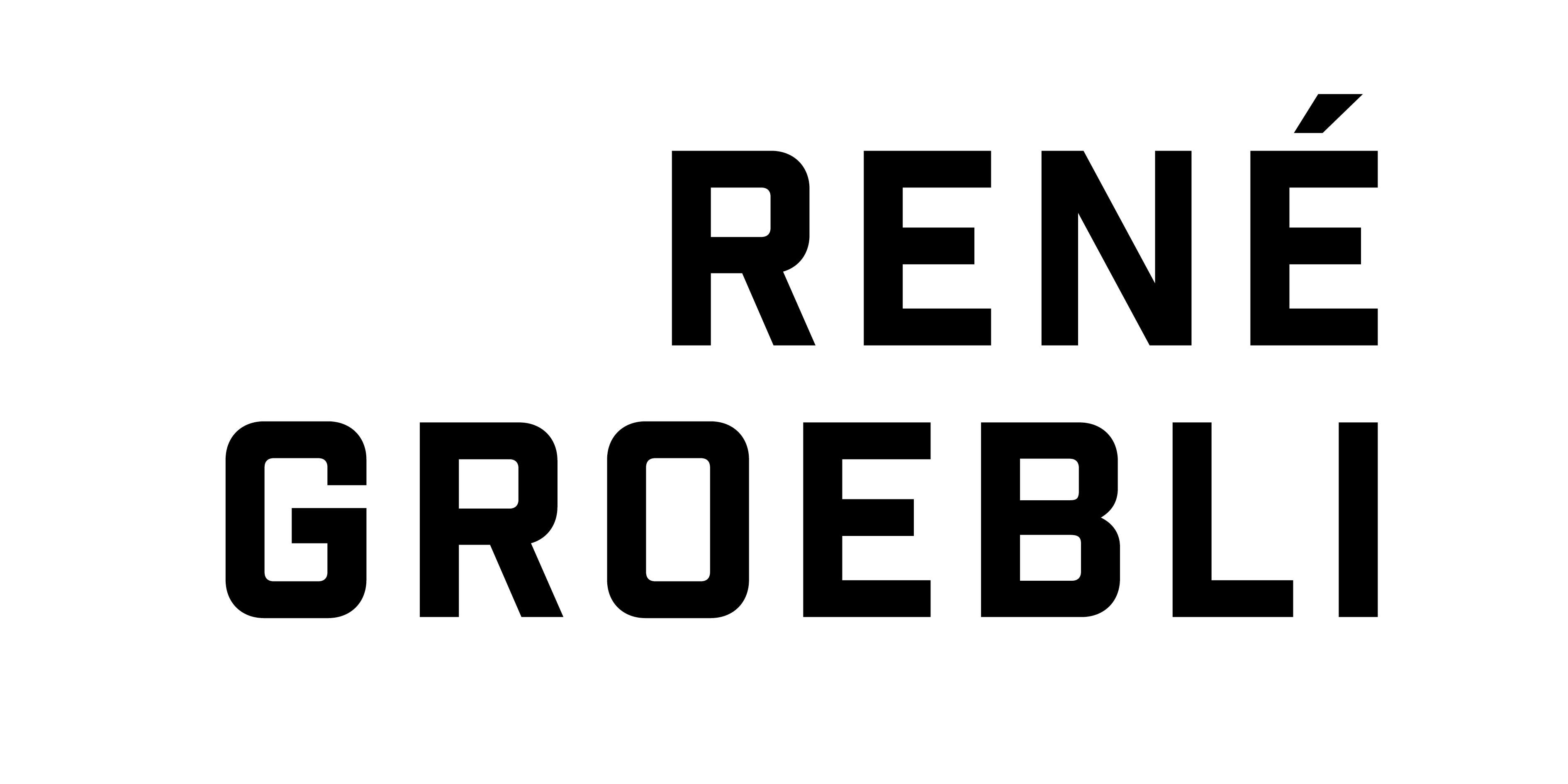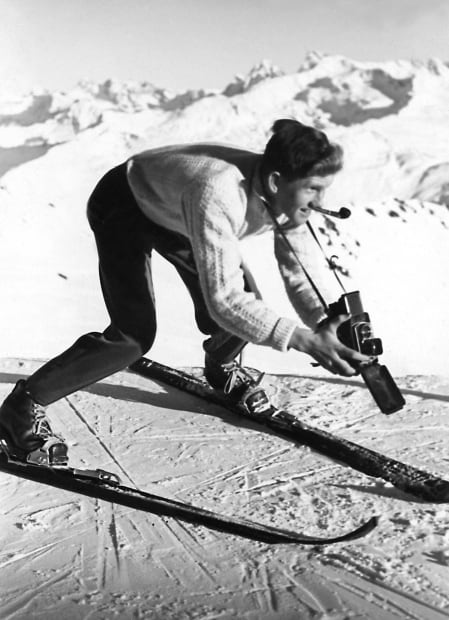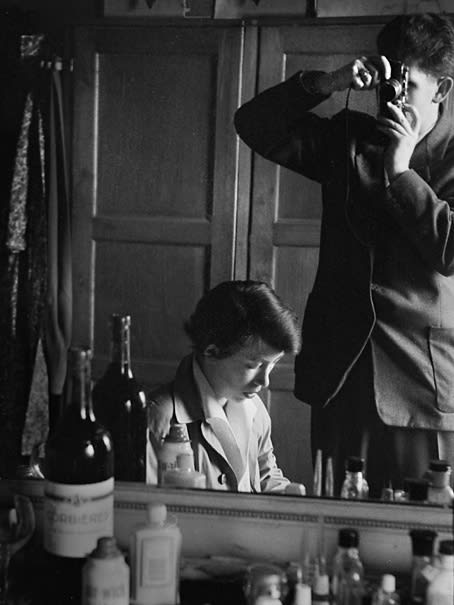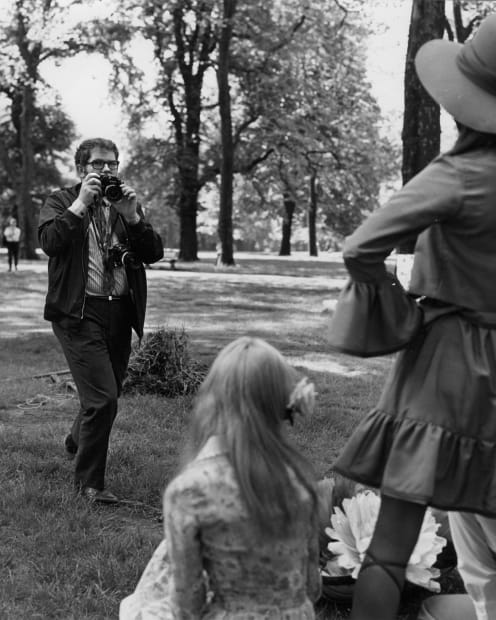-

René Groebli with this Rolleiflex, Parsenn, Davos, 1947
-
 René Groebli, self-portrait, 1953
René Groebli, self-portrait, 1953 -
 Rita and René in Paris, 1952
Rita and René in Paris, 1952 -
Waiting for his contemporaries to recognise the artistic value of his personal work, Groebli initially earned a living as a photo reporter. In addition to several Swiss publications, he worked for the Black Star Agency in London, which sent him on assignments in Africa and the Middle East, as well as for international and highly influential photojournalistic magazines such as Life Magazine and Picture Post. In the midst of this phase, Groebli married the love of his life, Rita Dürmüller, in 1951. She would support him artistically throughout his life. It is the pictures of their belated honeymoon in Paris for which Groebli would eventually achieve the greatest recognition as a photographic artist: Visually inspired by French Poetic Realism, Groebli shot a series of beautifully intimate, tender and warm images in their hotel room; a photographic love poem to his wife. Designed in collaboration with Werner Zyrnd, a booklet containing 25 of these images was published in 1954 under the title “Das Auge der Liebe” (The Eye of Love). The Eye of Love, too, initially met with little success in Switzerland - it was controversially discussed, dismissed as indecent and harshly criticised for its apparent sexual innuendos. Again, Groebli was ahead of his time; the photo book still had to establish itself as an art form in its own right. Today, the work is considered a milestone in the history of the photo book. Even Robert Frank and René Burri entered the terrain of artistically interested photojournalism years later with their important titles Les Américains (1958) and Die Deutschen (1962). In 1955, however, the magazine U.S. Camera Annual printed 10 pictures from the series, describing the work as “a tender photoessay on a photographer’s love for […] his wife”. Groebli had shown what it means to go beyond pure documentary photography to tell a story with a deliberately subjective point of view, and to translate this into a harmonious sequence of images in book form. In the same year, René Groebli was represented alongside the Swiss photographers Werner Bischof, Robert Frank and Gotthard Schuh at Edward Steichen’s groundbreaking exhibition The Family of Man at the Museum of Modern Art in New York, an ambitios exhibition, unprecedented in it’s scope and aim to present life in all its phases, facets and different cultural realities.
-
 René Groebli (green shirt) at his studio in Zurich, 1968
René Groebli (green shirt) at his studio in Zurich, 1968 -
With his colour work, Groebli contributed pioneering artistic work in this field, too. It is therefore not surprising that in 1957, the US Color Annual Magazine termed him “Master of Color”. His work as a colour photographer, advertiser and designer, as well as his love of experimentation in his free works, did not, of course, take place in a vacuum, though. As much as he may have influenced the photographic design of the 1960s and 70s, international art with optical and pop art, action painting or colour field painting may have, if not influenced him, then at least encouraged him in his eagerness to rethink the subject of colour.
-
 René Groebli shooting for the big Kodak Show at Photokina Cologne, London, 1968
René Groebli shooting for the big Kodak Show at Photokina Cologne, London, 1968 -
 René Groebli, 2018
René Groebli, 2018 -
COLLECTIONS
Museum of Modern Art (MoMA), New York, USAThe Museum of Fine Arts, Houston, Texas, USAMaison Européenne de la Photographie, Paris, FranceFolkwang Museum, Essen, GermanyFMAC Collection d'Art Contemporain Ville de Genève (formerly called Fonds municipal cantonale de décoration), Geneva, SwitzerlandSchweizerische Fotostiftung, Winterthur, SwitzerlandAuer-Ory Stiftung, Hermance, Geneva, SwitzerlandFondazione Galleria Gottardo (Banco del Gottardo), Lugano, SwitzerlandHungarian Musem for Photography, Kecskemét, Hungaryseveral private collections -
Exhibitions
SOLO SHOWS (SELECTION)1954Galerie 16, Zürich (CH)1966"Dye Transfers", Galerie 58, Rapperswil (CH)1978"Babylon, Babylon", Rencontres Internationales de la Photographie, Arles (FR)"Fantasies", Images Gallery, New York (US)1979"Fantasies", Galerie Contact, Bordeaux (FR)"Fantasies", Galerie Dieuzaide, Toulouse (FR)1979-80"Rêveries sur New York", Fnac Etoile, Paris (FR)1991"Retrospective", Tarazona 91, Tarazona (ES)1992"Photographies 1946 - 1991", Centre de la Photographie, Genève (CH)"Visions, photographies 1945-1991", Mairie du Xe, Mois de la photo, Paris (FR)"The Eye of Love & Rail Magic", Galerie Renée Ziegler, Zürich (CH)1993"Visionen" Brandenburgische Kunstsammlung, Cottbus (GER)1997"Rail Magic", Montpellier (FR)1998"Rail Magic", Galerie Camera Obscura, Paris (F)1999"Magie und Melancholie, Fotografien 1946 - 96", Kunsthaus Zürich (CH)2001"Irland"", Galerie Commercio, Zürich (CH)2002"The Eye of Love" & "Rail Magic", Paris Photo, Paris (FR)2003"Rail Magic", Robert Koch Gallery, San Francisco (US)"New York", Galerie DeArtis, Zug (CH)2005"Fotografien der 40er und 50er Jahre", Galerie in focus, Köln (GE)"Rail Magic" & "The Eye of Love", Magyar Fotografiai Muzeum, Kecskemét (HU)2006"The Eye of Love" & "Rail Magic", Kamera- und Fotomuseum, Leipzig (GER)2008"Rail Magic", Howard Greenberg Gallery, New York (US)"Life is Movement", Galerie deArtis, Zürich (CH)"Magie du Rail", Galerie Simon Studer, Genève (CH)2009"Retrospektive: 60 Jahre Fotografie", in focus Galerie, Köln (GER)2012"Hommage à René Groebli", Fondation Auer Ory, Hermanence (CH)"René Groebli. Nus", Cabinet d'expertise Témoin, Genève (CH)"René Groebli: Grands formats", Galerie Carry on, Genève (CH)2013"Hommage au féminin", Artpassions, La Galerie, Genève (CH)2014"Fotografien 1946 - 2002", Photobastei, Zürich (CH)2015"Magie du Rail & L'Oeuil de l'amour", Galerie Esther Woerdehoff, Paris (FR)"Early Work", Bildband, Berlin (GER)2016"Rail Magic", Museum im Bellpark, Kriens (CH)"Early Work", Galerie Bildhalle, Kilchberg/ZH (CH)"Nus", Galerie Esther Woerdehoff, Paris (FR)2017"Das Magische Auge - Zum 90. Geburtstag von René Groebli", Galerie Bildhalle, Zürich (CH)"Rail Magic", Galerie Kornhausforum, Bern (CH)"Nudes", Fototage Münsingen (CH)"Platinum Prints", Galerie Johanna Breede, Berlin (GE)2018Magie der Schiene", LRV-Industriemuseum, Zinkfabrik Altenberg, Oberhausen (GE)2020"The Magic Eye – René Groebli", Exhibition and book launch, Galerie Bildhalle, Zürich (CH)"The Eye of Love", Galerie Bildhalle, Amsterdam (NL)"Farbzauberer", Chaussée 36, Berlin (GER)2021"Icônes et inédits", Centre d'Art Contemporain (BAC), Le Commun, Genève (CH)2024"René Groebli – Meisterwerke der Metropolen: London, Paris", Galerie Buchkunst Berlin (GER),"René Groebli", Westlicht, Schauplatz für Fotografie, Wien (AUT)Group Exhibitions (Selection)1951"Subjektive Fotografie", Staatliche Schule für Kunst und Handwerk, Saarbrücken (GER)1952Weltausstellung der Fotografie, Luzern (CH)1955The Family of Man, curated by Edward Steichen, MoMa, New York (US)"Photographie als Ausdruck", zweite Ausstellung des Kollegiums Schweizer Fotografen, Helmhaus, Zürich (CH)1974"Schweizer Photographie von 1840 bis heute", Kunsthaus Zürich (CH)1976-78"Fantastic Photography in Europe II", Canon Photo Gallery, Amsterdam (NL) + (EU),1981European Museums Collection, Kunsthas Zürich (CH) + (EUR)Sammlung Otto Steinert, Museum Folkwang, Essen"111 Photographien", Sammlung der Schweizer Stiftung für Fotografie, Kunsthaus Zürich (CH)1984-86"Subjektive Fotografie", (US, GE, CH, BRA)1986"Neuerwerbungen und Geschenke", Kunsthaus, Zürich (CH)1990"Le Train", Centre National de la Photographie (CNP), Paris (F)1995Collezione di Fotografia Svizzera della Banca del Gottardo, Bellinzona (CH)1996"Im Kunstlicht", Kunsthaus Zürich (CH)1997"Made in Switzerland - les collections de photographies suisses de la confédération", Musée de l'Elysée, Lausanne (CH)1998"A la recherche du temps suspendu", Musée suisse de l'appareil photographique, Vevey (CH)2002"New York après New York", Musée de l'Elysée, Lausanne (CH)2003"Trains", Maison Robert Doisneau, Gentilly-Paris (FR)2007"Regarde! des enfants: de la naissance à l'adolescence, un parcours photographique de 1840 à nos jours dans la collection M+M Auer", Pavillon Populaire, Montpellier (FR)2010"Photographie Américaine: Regards sur la collection M+M Auer", Galerie Françoise Besson, Lyon (FR)2011"Die Schweiz im Fotobuch", Fotomuseum Winterthur (CH)2012"Another London", Tate Britain, London (UK)Europäischer Monat der Fotografie, Pinter & Milch Galerie für Fotografie, Berlin (GE)2015"Drive in", Galerie Bildhalle, Kilchberg/ZH (CH)2017Art Beirut, Galerie Esther Woerdehoff, Beirut (LB)"L'Oeuil de l'amour", Nuits de la Photographie, La Chaux de Fonds (CH)2018"5 Years down the Road – Anniversary Exhibition", Galerie Bildhalle, Zürich (CH)2019"Icons", Galerie Bildhalle, Zürich (CH)"Magie du Silence", Johanna Breede, Photokunst, Berlin (GE)2020"Fernweh", Galerie Bildhalle, Zürich (CH)"10 Years Bildhalle – Anniversary Exhibition", Galerie Bildhalle, Zürich (CH)2022"Love Songs. Photographies de l'intime", Maison Européenne de la Photographie (MEP), Paris (FR)2023/4"Coming to Light – 16 Artists – Historical and Innovative Printing Techniques"", Galerie Bildhalle, Zürich (CH)2025The Photography Show 2025 (AIPAD), New York (US)Photo London 2025, London (UK)"Blooming", Galerie Bildhalle, Zürich (CH)







